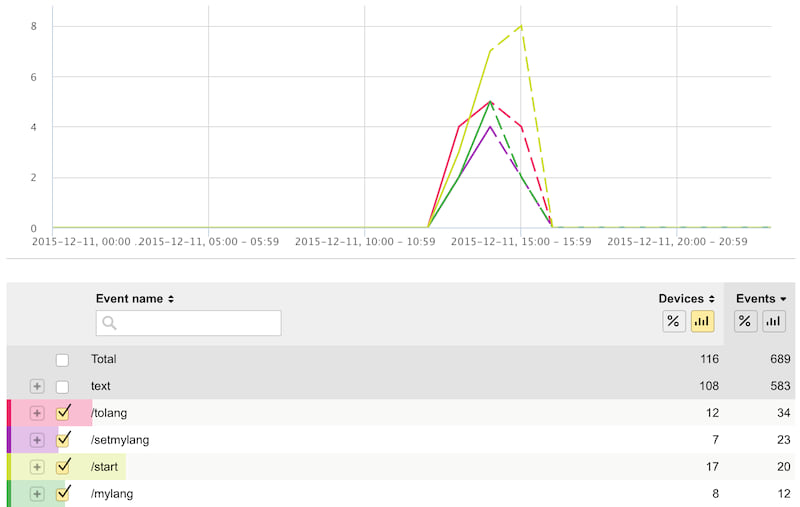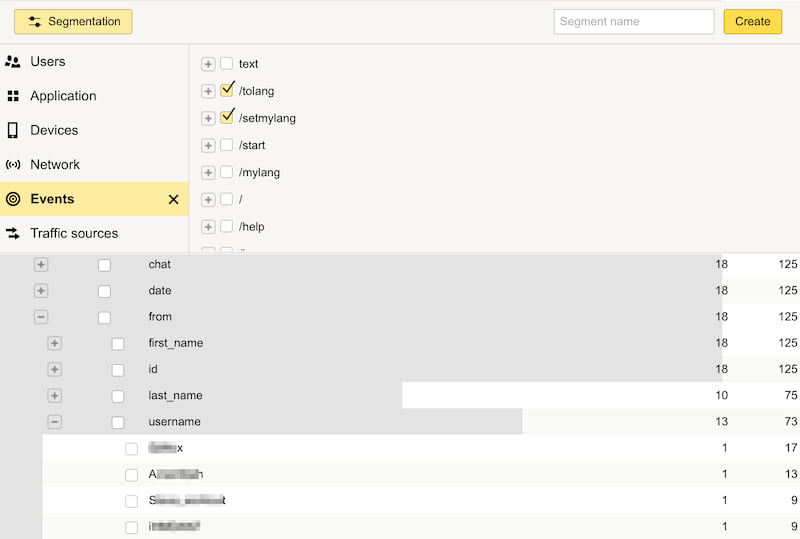1 unstable release
Uses old Rust 2015
| 0.1.0 | Dec 2, 2015 |
|---|
#70 in #telegram-bot
6KB
103 lines
This service will be shut down on 25th May 2018
Due to many reasons, we're going to shut down this service soon. You can use these alternatives:
- Chatbase — bot analytics from Google,
- Dashbot,
- Botanalytics,
- Amplitude — it has generous free plan with 10M events per month. It's a powerful analytics but have nothing specific to bots.
About this service
Botan is a telegram bot analytics system based on Yandex.Appmetrica. In this document you can find how to setup Yandex.Appmetrica account, as well as examples of Botan SDK usage.
Botan has 2 main use cases:
- Send to Botan info about every message sent by user and get basic usage stats like DAU, MAU, Retention, Commands and more complicated details.
- Get extended information about users by wrapping links you send to them — location, languages, devices and operating systems of your users.
Creating an account
- Register at http://appmetrica.yandex.com/
- After registration you will be prompted to create Application. Please use @YourBotName as a name.
- Save an API key from settings page, you will use it as a token for Botan API calls.
- Download lib for your language, and use it as described below. Don`t forget to insert your token!
SDK usage
We have libraries for the following languages:
Alternatively, you can use Botan API via plain HTTP calls.
In case your preferred language is missed, you can make a contribution. It's easy — library usually contains 30 lines of code.
Also, pay attention to "what data to put into tracking data" section. 90% benefit from analytics usage lies in right integration;)
JavaScript example
Install npm: npm install botanio
var botan = require('botanio')(token);
botan.track(message, 'Start');
var uid = message.from.id;
var url = 'https://github.com/'; // some url you want to send to user
botan.shortenUrl(uid, url, function (err, res, body) {
if (err) {
console.error(err);
} else {
console.log(body); // shortened url here
}
});
Python example
You need to install requests library to use python botan lib. You can do it with
pip install requests
Code:
import botan
botan_token = '.........' # Token got from @botaniobot
uid = message.from_user
message_dict = message.to_dict()
event_name = update.message.text
print botan.track(botan_token, uid, message_dict, event_name)
.....
original_url = ... # some url you want to send to user
short_url = botan.shorten_url(original_url, botan_token, uid)
# now send short_url to user instead of original_url, and get geography, OS, Device of user
PHP example
You need to put the class in a convenient place.
private $token = 'token';
public function _incomingMessage($message_json) {
$messageObj = json_decode($message_json, true);
$messageData = $messageObj['message'];
$botan = new Botan($this->token);
$botan->track($messageData, 'Start');
...
$original_url = ...
$uid = $message['from']['id']
$short_url = $botan->shortenUrl($url, $uid)
// now send short_url to user instead of original_url, and get geography, OS, Device of user
}
Ruby example
uid is a user id you get from Telegram.
require_relative 'botan'
token = 1111
uid = 1
message = { text: 'text' }
puts Botan.track(token, uid, message, 'Search')
Rust example
extern crate rustc_serialize;
extern crate botanio;
use botanio::{Botan};
#[derive(Debug, RustcEncodable)]
struct Message {
some_metric: u32,
another_metric: u32,
}
fn main() {
let token = "1111";
let uid = 1;
let name = "Search";
let message = Message {some_metric: 100, another_metric: 500};
let botan = Botan::new(token);
botan.track(uid, name, &message).unwrap();
}
Java example
try (CloseableHttpAsyncClient client = HttpAsyncClients.createDefault()) {
client.start();
Botan botan = new Botan(client, new ObjectMapper());
botan.track("1111", "1", ImmutableMap.of("some_metric": 100, "another_metric": 500), "Search").get();
}
Go example
package main
import (
"fmt"
"github.com/botanio/sdk/go"
)
type Message struct {
SomeMetric int
AnotherMetric int
}
func main() {
ch := make(chan bool) // Channel for synchronization
bot := botan.New("1111")
message := Message{100, 500}
// Asynchronous track example
bot.TrackAsync(1, message, "Search", func(ans botan.Answer, err []error) {
fmt.Printf("Asynchonous: %+v\n", ans)
ch <- true // Synchronization send
})
// Synchronous track example
ans, _ := bot.Track(1, message, "Search")
fmt.Printf("Synchronous: %+v\n", ans)
<-ch // Synchronization receive
}
Haskell example
import Network.HTTP.Client (newManager)
import Network.HTTP.Client.TLS (tlsManagerSettings)
import Servant.Client
import Web.Botan.Sdk
import GHC.Generics
import Data.Aeson
import Control.Concurrent.Async
main :: IO ()
main = do
manager <- runIO $ newManager tlsManagerSettings
let message = toJSON $ AnyMessage "A" "B"
a <- async $ track "token" "user2222" message "test_action" manager
res <- wait a -- not real use case
print res
data AnyMessage = AnyMessage
{
a :: Text
, b :: Text
} deriving (Show, Generic, ToJSON)
HTTP API
Track message
The base url is: https://api.botan.io/track
You should put data to Botan using POST method.
The url should look like https://api.botan.io/track?token=API_KEY&uid=UID&name=EVENT_NAME
Please provide a json document as the post body.
API response is a json document:
- on success: {"status": "accepted"}
- on failure: {"status": "failed"} or {"status": "bad request", "info": "some_additional_info_about_error"}
Shorten url
Send GET request to
https://api.botan.io/s/?token={token}&url={original_url}&user_ids={user_id}
You get shortened url in a plain-text response (in case the response code was 200). Codes other than 200 mean that an error occurred.
Also, in case of group chats you can add several user_ids: &user_ids={user_id_1},{user_id_2},{user_id_3}, but currently this data will not be used (because we don't know which particular user clicked link).
What to put into tracking data
###Basic integration
botan.track(<botan_token>, <user_who_wrote_to_bot>, <user_message_in_json_format>, <command_name>)
- command_name - we recommend to put here not just message text, but command. Example: user wrote '/search californication', put to command_name 'Search'. This will help you to aggregate type of user's input and get such report:

- user_message_in_json_format - whole message got from Telegram. For example, using python-telegram-bot you can do it in such way: message.to_dict(). Passing whole message, you will be able to see nice data like number of group chats among all chats:
 Also you will be able to get userids who performed some particular action (through segmentation) or your most active users and contact them:
Also you will be able to get userids who performed some particular action (through segmentation) or your most active users and contact them:

###Advanced integration Actually, most benefit from analytics usage lies in sending right events with right data inside. Here is some best practices we recommend. Feel free to contribute your ways or improve existing ones.
#####Commands order That's how you can see what command users execute after which:
botan.track(<botan_token>, <user_who_wrote_to_bot>, {last_command: current_command}, "command_order")
Also you can send not pairs, but triples of commands:
botan.track(<botan_token>, <user_who_wrote_to_bot>, {before_last_command: {last_command: current_command}}, "command_order")
Using this, we can see, for example, what commands users execute after /start:
 #####Date cohorts
Here is how you can tag every user with time cohort based on what was his first day at your service. Later you can use to see how your bot's performance has changed over time:
#####Date cohorts
Here is how you can tag every user with time cohort based on what was his first day at your service. Later you can use to see how your bot's performance has changed over time:
if this_is_first_occurence_of_user:
botan.track(<botan_token>,
<user_who_wrote_to_bot>,
{
'daily': message.date.strftime('%Y-%m-%d'),
'weekly': (message.date - datetime.timedelta(message.date.weekday())).strftime('%Y-%m-%d'),
'monthly': message.date.strftime('%Y-%m')
},
'cohorts')
Get user profiles by wrapping links
###How it works You create unique short link for each pair (user, link). When user clicks the link, Botan stores his user agent, IP address and other stuff. After that you'll be able to use user segmentation by geography, language, device and operating system (and see corresponding statistics).
###What url to wrap We suggest you to wrap every url that you send to user. Most often use case is sending "please rate us" link — most popular bots asks for rating in storebot.me.
###What you will get You'll get a lot of useful new data in the web interface:
Countries, regions and cities

Devices

Operating systems

Locales

###How to use Here you can find examples for Python, PHP. Feel free to make pull requests with wrappers for other languages (here's HTTP spec for the shortener).
##Contribution We are welcome any contributions as pull-requests!
Feel free to write more libraries for the languages we are not supporting yet.
lib.rs:
Botan is a telegram bot analytics system based on Yandex.Appmetrica.
Creating an account
Register at http://appmetrica.yandex.com/.
After registration you will be prompted to create Application. Please use @YourBotName as a name.
Save an API key from settings page, you will use it as a token for Botan initalization.
For more information see examples.
Dependencies
~5MB
~97K SLoC